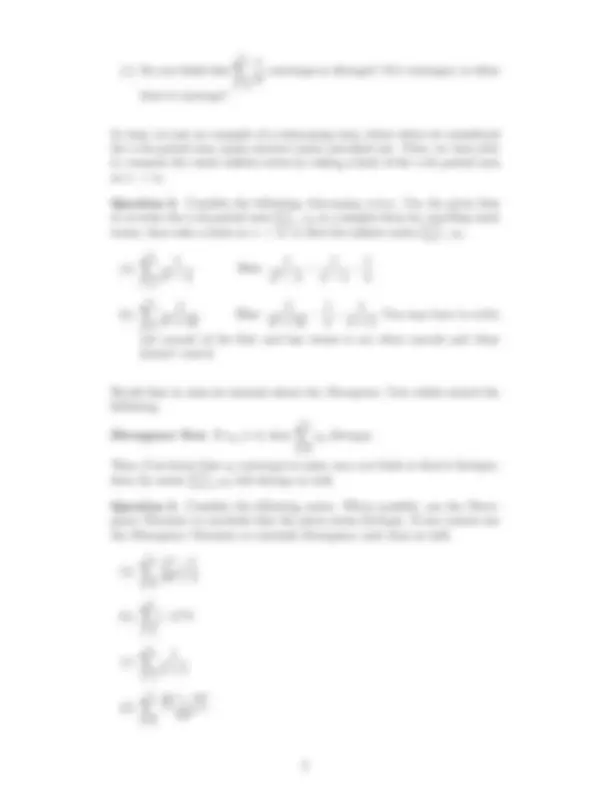



Study with the several resources on Docsity

Earn points by helping other students or get them with a premium plan


Prepare for your exams
Study with the several resources on Docsity

Earn points to download
Earn points by helping other students or get them with a premium plan
Community
Ask the community for help and clear up your study doubts
Discover the best universities in your country according to Docsity users
Free resources
Download our free guides on studying techniques, anxiety management strategies, and thesis advice from Docsity tutors
Instructions for calculating the first six partial sums of the given infinite series ∞k=0 1k! and comparing their values to the natural number e. It also introduces the concept of telescoping series and provides examples for computing the infinite series by taking the limit of the n-th partial sum as n → ∞. Additionally, it discusses the divergence test and its application to determining the divergence of certain series.
Typology: Assignments
1 / 2

This page cannot be seen from the preview
Don't miss anything!


In class, we learned that to truly understand the infinite series
∑^ ∞
k=
ak = a 0 + a 1 + a + 2 + · · · + an + · · ·
we must first understand the n-th partial sum
∑^ n
k=
ak = a 0 + a 1 + · · · + an
and then take a limit of these partial sums as n → ∞.
Question 1. Consider the sequence
∑^ ∞
k=
k!
(a) Find the first 6 partial sums. To do this, you will need to use the interesting fact that 0! = 1. When adding, please keep at least six decimal places. Thus, you need to compute the following seven sums:
∑^0
k=
k!
k=
k!
k=
k!
k=
k!
k=
k!
k=
k!
k=
k!
(b) As your partial sum
∑^ n
k=
k! increases, compare its value to that of the
natural number e ≈ 2. 718281828 ...
(c) Do you think that
k=
k!
converges or diverges? If it converges, to what
does it converge?
In class, we saw an example of a telescoping sum, where when we considered the n-th partial sum, many interior terms cancelled out. Then, we were able to compute the entire infinite series by taking a limit of the n-th partial sum as n → ∞.
Question 2. Consider the following telescoping series. Use the given hint to re-write the n-th partial sum ∑n k=1 ak^ in a simpler form by canceling most terms, then take a limit as n → ∞ to find the infinite series
k=1 ak.
(a)
k=
k^2 − k
Hint:
k^2 − k
k − 1
k
(b)
k=
k^2 + 2k Hint:
k^2 + 2k
k
k + 2
. You may have to write
out several of the first and last terms to see what cancels and what doesn’t cancel.
Recall that in class we learned about the Divergence Test, which stated the following.
Divergence Test. If ak 6 → 0, then
k=
ak diverges.
Thus, if we know that ak converges to some non-zero limit or that it diverges, then the series
k=0 ak^ will diverge as well.
Question 3. Consider the following series. When possible, use the Diver- gence Theorem to conclude that the given series diverges. If you cannot use the Divergence Theorem to conclude divergence, note that as well.
(a)
k=
k^2 − k 7 k^2 + 1
(b)
k=
(−1)kk
(c)
k=
k + 1
(d)
k=
3 k^4 + 7k^2 5 k^6